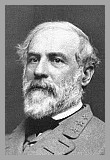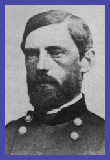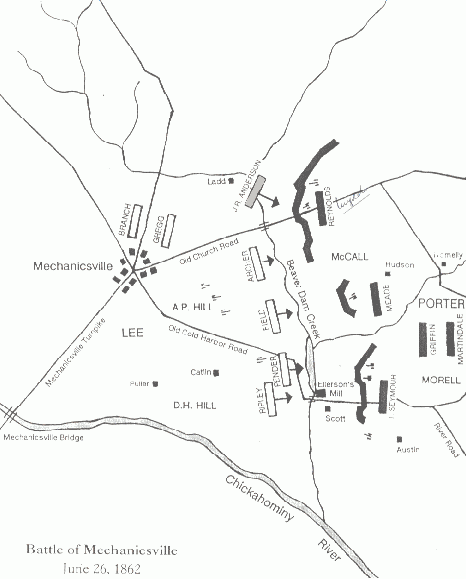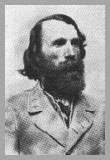|

Robert
E Lee
courtesy
General
Officers of the Civil War
Lee
moved quickly, restructuring his forces. In a move both politically and
militarily motivated, Lee again moved regiments around. This time he put
state regiments together into brigades. The 35th Georgia was placed with
the 14th, 45th, and 49th Georgia Regiment's to form a new brigade, along
with the 3rd Louisiana, and placed under the command of General Joseph Reid
Anderson. Anderson was a West Point graduate and part owner of the Tredegar
Iron Works in Richmond, Virginia. Anderson's mostly Georgia brigade was placed
with the Virginian regiments under Gen Field's, the North Carolinian brigade
under Gen Branch, and South Carolinian's under Gen Gregg. Also forming the
new Division were the North Carolinian regiments under Gen Pender and the
mostly Tennessee brigade (one Alabama and one Georgia) under Gen Archer.
courtesy
General
Officers of the Civil War
These 6 brigades formed a new "Light Division" and placed under the command
of newly promoted Major General Ambrose Powell Hill. AP Hill had graduated
West Point in the class of 47, schooling alongside classmates who would become
some of most notable leaders of the Civil War. In particular, his roommate
and close friend in his early school years, was a young man by the name of
George B McClellan, now commanding the enemy forces around Richmond. In his
sophomore year, Hill's life would be forever changed, when on a trip to New
York City, he contracted a venereal disease. This condition would later cost
him the hand of his sweetheart, Ellen "Nelly" Marcy, who then dated, and
later married, the same George B McClellan.
For the first three weeks of June, Hill's new division trained and built
earthworks south of the Chickahominy River, east and west of the Mechanicsville
bridges. In a letter on June 8, 1862, Capt White of Company B wrote home
that his troops were stationed at Camp Reserve. On June 23rd, Hill joined
General's James Longstreet, Daniel Harvey Hill, and Thomas "Stonewall" Jackson
in Lee's headquarters to plan an attack. On the 25th, the men of the 35th
were given two day's ration, and that afternoon, the Light Division was on
the move. By the next morning, the Light Division was massed in the woods,
southeast of Mechanicsville. The original plan of attack was for Hill to
wait for Jackson to arrive northeast of Mechanicsville with his division
before advancing into the town. But Jackson was running way behind schedule,
and by 3 pm, Hill could wait no longer. His lead troops pushed into
Mechanicsville, which the Union Army only lightly resisted, choosing instead
to fall back to the fortified heights overlooking the town to the east. Swinging
to their right, the brigades were ordered to make an assault on the entrenched
Union 5th Corps under Union General Fitz John Porter.
Anderson's Georgia third brigade held the left flank of the division line.
To their right, Archer, Field, and Pender lined up their respective regiments,
with Gregg and Branch in reserve. Facing the Georgian's were the 1st, 5th,
8th, the 13th Pennsylvania Reserves (6 companies), companies C and G of the
Berdan sharpshooters, and the 1st Pennsylvania battery. These were the men
of the 3rd Division 1st Brigade under General John Fulton Reynolds.

John
F Reynolds
courtesy
General
Officers of the Civil War
Their
position across the Beaver Dam Creek was formidable. One soldier from the
13th Pennsylvania, known as the Bucktail Regiment, because of the bucktail's
each soldier wore in his cap, wrote "Thus we were on the extreme right
of the Army of the Potomac, and in the Fifth Corps, then commanded by Fitz
John Porter. Our position was naturally a strong one. On the front of our
camp was a swamp which was almost impassable, and a dam having been built
at the road backed the water over a large scope of land which made it still
worse so that it was a great protection to the extreme right of our regiment.
The left of regiment extended to the Mechanicsville and Richmond road, and
was joined by the fifth reserves. A large ravine extended to the creek, thus
cutting off all chances of crossing at that place. Our camp was on an elevation
of at least fifty feet above the creek, and the ground was covered with a
heavy growth of timber...The village of Mechanicsville was situated about
half a mile in our front, and the Chickahominy river an our left and running
in a diagonal direction with our line. Our picket line was an one aide of
the river --- a narrow sluggish stream --- and those of the enemy on the
opposite side. A bridge crossed the river on the Richmond road, and at-night
the pickets on both-sides were advanced to the ends of the bridge and very
often would converse with each other, and exchange coffee, sugar, etc. for
which the enemy would give us tobacco....Our picket duty while here was attended
to with extreme caution on both aides, and each party were always on the
alert. We all realized that a great battle was about to take place. We had
already learned that If "eternal vigilance was the price of Liberty," and
each watched the other at all times both night and day….. Monday and
Tuesday (23 and 24) we continued working on our rifle pits, and finished
them on the 25th."Holland, William A.,
"The
Old Bucktails--Their History", Duncannon Record, August 24, 1988
At 6 pm the order to advance was given. The brigade's on Anderson's right
made initial contact with the enemy, but soon the Georgian's emerged from
the trees and were under fire. As dusk began to fall, the 35th was fully
engaged and the only regiment of Hill's Division to successfully cross the
chest high, fifteen foot wide swamp surrounding the creek, and establish
a beachhead on the Union side. Under infantry fire from the Pennsylvanian's
and Capt Mark Kern's Napoleon's firing double canister into their forces,
the 35th held tediously to their captured territory. The 14th and 49th Georgia
attempted to aide the 35th, but were driven back. The attack was doomed from
the beginning. The fortified Union line was too strong, and without the forces
of Jackson present, the attack soon stalled. Eventually Hill's division began
to crumble and fall back under the severe fire. Unable to be supported, the
35th now found themselves in danger of being cut off, and retreated back
across the creek and swamp. Holland of the Bucktail Regiment wrote "About
4 o'clock the Rebels made their appearance in our front, and commenced a
brisk skirmish with a portion of the First Regiment Penn. RVC who soon retired
to their works on our right. I saw a heavy column of Rebel infantry coming
in our front, and instantly our artillery opened on them, they being too
far off for our rifles, as we lay behind our pits. Soon, however, the engagement
became general, and on our left the firing was very heavy, it being the second
brigade of our Division engaged there. Toward evening the Rebels came down
to the opposite side of the swamp in our front, but no sooner did they do
so than we let loose on them with our rifles with terrible effect and in
the meantime the artillery firing was very heavy. Battery B did good service,
and when darkness closed the fighting for the day the groans of the Rebels
were almost heart-rending. I found it almost impossible to sleep." Holland,
William A.,
"The
Old Bucktails--Their History", Duncannon Record, August 24, 1988

As night fell, the defeated Confederates went about the task of gathering
their wounded and burying the dead. It would be called the Battle of
Mechanicsville, or "Beaver Dam Creek" and it cost the 35th dearly. 18 more
of their men were killed and another 61 were wounded. Company C was especially
damaged , losing Captain David Henry and 1st Lt Hope Roberts, both killed,
and 2nd Lt Solomon Johnson, who was injured with a compound fracture of his
left ankle. The division adjutant also fell. In a book written about the
Christian revival of the Southern Army, Rev. E. W. Yarbrough, a chaplain
in the Confederate Army
was
quoted "Our Adjutant, J. H. Ware, was killed. As Colonel Thomas bent
over him, the heroic youth grasped his hand and delivered his dying message:
'My dear Colonel, tell my mother that I fell in the discharge of my duty,
and died happy."
In
its first two engagement's alone, the little Georgia regiment had seen a
little over ¼ of its men become casualties of war. Total casualties
in this battle for the Confederacy were nearly 1300, while the entrenched
Union suffered only about 400.
|




